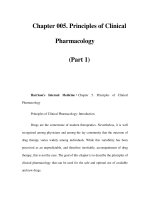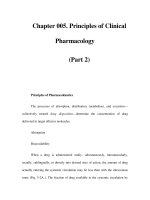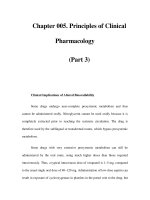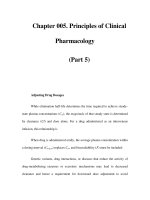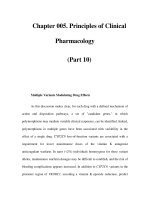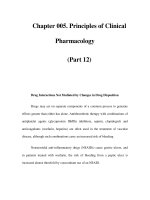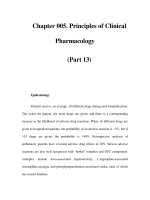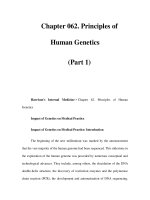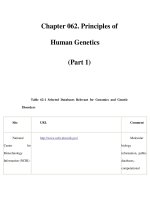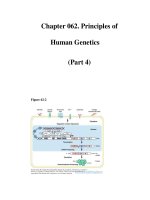Chapter 062. Principles of Human Genetics (Part 15) doc
Bạn đang xem bản rút gọn của tài liệu. Xem và tải ngay bản đầy đủ của tài liệu tại đây (43.9 KB, 5 trang )
Chapter 062. Principles of
Human Genetics
(Part 15)
Unequal Crossing-Over
Normally, DNA recombination in germ cells occurs with remarkable
fidelity to maintain the precise junction sites for the exchanged DNA sequences
(Fig. 62-3). However, mispairing of homologous sequences leads to unequal
crossover, with gene duplication on one of the chromosomes and gene deletion on
the other chromosome. A significant fraction of growth hormone (GH) gene
deletions, for example, involve unequal crossing-over (Chap. 333). The GH gene
is a member of a large gene cluster that includes a growth hormone variant gene as
well as several structurally related chorionic somatomammotropin genes and
pseudogenes (highly homologous but functionally inactive relatives of a normal
gene). Because such gene clusters contain multiple homologous DNA sequences
arranged in tandem, they are particularly prone to undergo recombination and,
consequently, gene duplication or deletion. On the other hand, duplication of the
PMP22 gene because of unequal crossing-over results in increased gene dosage
and type IA Charcot-Marie-Tooth disease. Unequal crossing-over resulting in
deletion of PMP22 causes a distinct neuropathy called hereditary liability to
pressure palsy (Chap. 379).
Glucocorticoid-remediable aldosteronism (GRA) is caused by a
rearrangement involving the genes that encode aldosterone synthase (CYP11B2)
and steroid 11β-hydroxylase (CYP11B1), normally arranged in tandem on
chromosome 8q. These two genes are 95% identical, predisposing to gene
duplication and deletion by unequal crossing-over. The rearranged gene product
contains the regulatory regions of 11β-hydroxylase fused to the coding sequence
of aldosterone synthetase. Consequently, the latter enzyme is expressed in the
adrenocorticotropic hormone (ACTH)-dependent zona fasciculata of the adrenal
gland, resulting in overproduction of mineralocorticoids and hypertension (Chap.
336).
Gene conversion refers to a nonreciprocal exchange of homologous genetic
information; it is probably more common than generally recognized. In human
genetics, gene conversion has been used to explain how an internal portion of a
gene is replaced by a homologous segment copied from another allele or locus;
these genetic alterations may range from a few nucleotides to a few thousand
nucleotides. As a result of gene conversion, it is possible for short DNA segments
of two chromosomes to be identical, even though these sequences are distinct in
the parents. A practical consequence of this phenomenon is that nucleotide
substitutions can occur during gene conversion between related genes, often
altering the function of the gene. In disease states, gene conversion often involves
intergenic exchange of DNA between a gene and a related pseudogene. For
example, the 21-hydroxylase gene (CYP21A2) is adjacent to a nonfunctional
pseudogene (CYP21A1P). Many of the nucleotide substitutions that are found in
the CYP21A2 gene in patients with congenital adrenal hyperplasia correspond to
sequences that are present in the CYP21A1P pseudogene, suggesting gene
conversion as a mechanism of mutagenesis. In addition, mitotic gene conversion
has been suggested as a mechanism to explain revertant mosaicism in which an
inherited mutation is "corrected" in certain cells. For example, patients with
autosomal recessive generalized atrophic benign epidermolysis bullosa have
acquired reverse mutations in one of the two mutated COL17A1 alleles, leading to
clinically unaffected patches of skin.
Insertions and Deletions
Though many instances of insertions and deletions occur as a consequence
of unequal crossing-over, there is also evidence for internal duplication, inversion,
or deletion of DNA sequences. The fact that certain deletions or insertions appear
to occur repeatedly as independent events suggests that specific regions within the
DNA sequence predispose to these errors. For example, certain regions of the
DMD gene appear to be hot spots for deletions. Some regions within the human
genome are rearrangement hot spots and lead to CNVs (see above).
Errors in DNA Repair
Because mutations caused by defects in DNA repair accumulate as somatic
cells divide, these types of mutations are particularly important in the context of
neoplastic disorders (Chap. 80). Several genetic disorders involving DNA repair
enzymes underscore their importance. Patients with xeroderma pigmentosum have
defects in DNA damage recognition or in the nucleotide excision and repair
pathway (Chap. 83). Exposed skin is dry and pigmented and is extraordinarily
sensitive to the mutagenic effects of ultraviolet irradiation. More than 10 different
genes have been shown to cause the different forms of xeroderma pigmentosum.
This finding is consistent with the earlier classification of this disease into
different complementation groups in which normal function is rescued by the
fusion of cells derived from two different forms of xeroderma pigmentosum.
Ataxia telangiectasia causes large telangiectatic lesions of the face,
cerebellar ataxia, immunologic defects, and hypersensitivity to ionizing radiation
(Chap. 368). The discovery of the ataxia telangiectasia mutated (ATM) gene
reveals that it is homologous to genes involved in DNA repair and control of cell
cycle checkpoints. Mutations in the ATM gene give rise to defects in meiosis as
well as increasing susceptibility to damage from ionizing radiation. Fanconi's
anemia is also associated with an increased risk of multiple acquired genetic
abnormalities. It is characterized by diverse congenital anomalies and a strong
predisposition to develop aplastic anemia and acute myelogenous leukemia (Chap.
104). Cells from these patients are susceptible to chromosomal breaks caused by a
defect in genetic recombination. At least eight different complementation groups
have been identified, and several loci and genes associated with Fanconi's anemia
have been mapped or cloned. HNPCC (Lynch syndrome) is characterized by
autosomal dominant transmission of colon cancer, young age (<50 years) of
presentation, predisposition to lesions in the proximal large bowel, and associated
malignancies such as uterine cancer and ovarian cancer. HNPCC is caused by
mutations in one of several different mismatch repair (MMR) genes including
MutS homologue 2 (MSH2), MutL homologue 1 (MLH1), and MSH6 (Chap. 87).
These enzymes are involved in the detection of nucleotide mismatches and in the
recognition of slipped-strand trinucleotide repeats. Germline mutations in these
genes lead to microsatellite instability and a high mutation rate in colon cancer.
Genetic screening tests for this disorder are now being used for families
considered to be at risk (Chap. 64). Recognition of HNPCC allows early screening
with colonoscopy and the implementation of prevention strategies using
nonsteroidal anti-inflammatory drugs.
